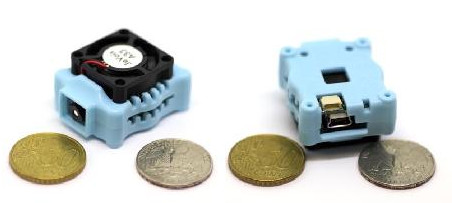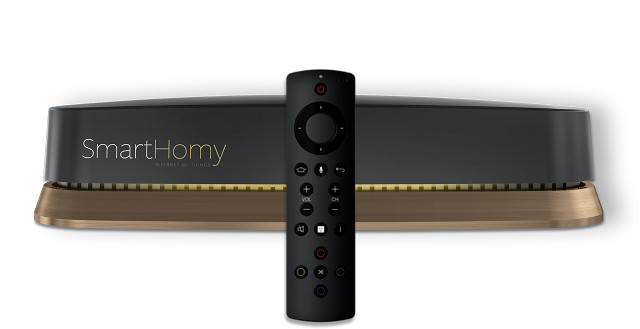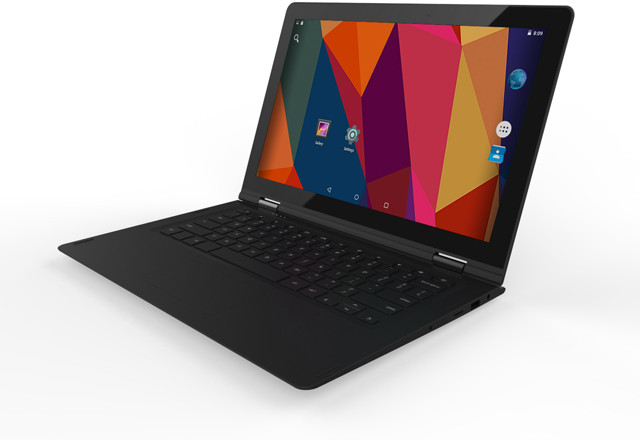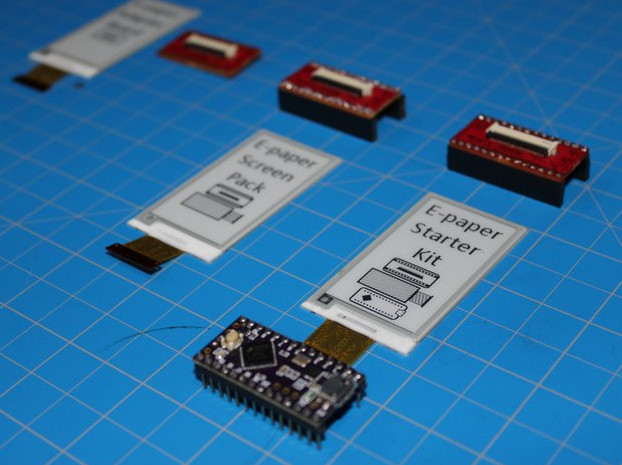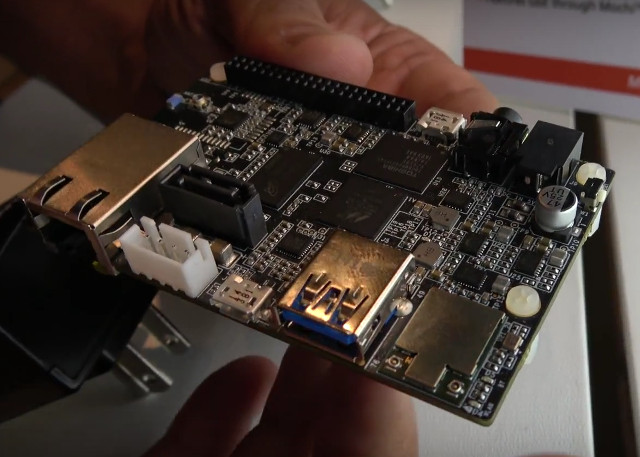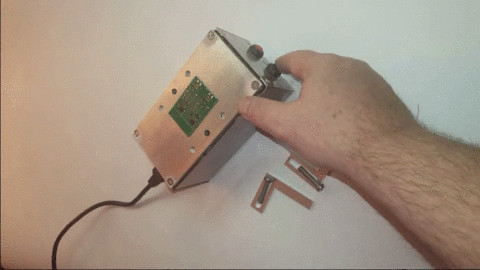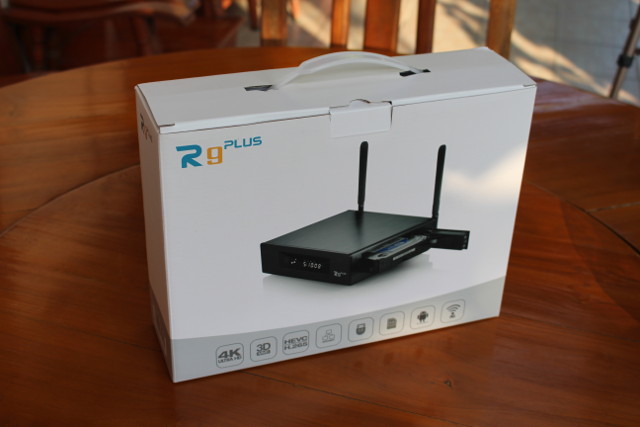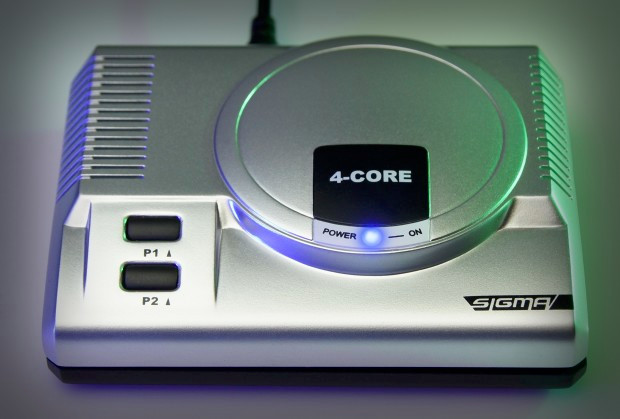JeVois Neuromorphic Embedded Vision Toolkit – developed at iLab at the University of Southern California – is an open source software framework to capture and process images through a machine vision algorithm, primarily designed to run on embedded camera hardware, but also supporting Linux board such as the Raspberry Pi. A compact Allwinner A33 has now been design to run the software and use on robotics and other projects requiring a lightweight and/or battery powered camera with computer vision capabilities. JeVois-A33 camera: SoC – Allwinner A33 quad core ARM Cortex A7 processor @ 1.35GHz with VFPv4 and NEON, and a dual core Mali-400 GPU supporting OpenGL-ES 2.0. System Memory – 256MB DDR3 SDRAM Storage – micro SD slot for firmware and data 1.3MP camera capable of video capture at SXGA (1280 x 1024) up to 15 fps (frames/second) VGA (640 x 480) up to 30 fps CIF (352 x 288) […]
SmartHomy Hybrid TV Box with DTV Tuner Triples as a Game Console & Home Automation Gateway (Crowdfunding)
SmartHomy Homy Player is a TV box running Android TV that includes an ATSC, DVB-T2/C,DVB-S2, or ISDB-T tuner, is said to be powerful enough to be used as a 3D gaming platform, and serves as a security system and home automation gateway using Z-Wave, Bluetooth, WiFi and IR blaster to control your things. Homy player specifications [Updated on January 19th, 2017]: SoC – Amlogic S912 octa-core Cortex A53 processor with Mali T820MP3 GPU System Memory – 3 GB DDR3 Storage – 32 GB eMMC flash Video Output – HDMI 2.0 up to 4K @ 60Hz with HDCP 2.2, HDR, CEC Audio Output – HDMI and optical S/PDIF Video / Audio Capabilities – 10-bit 4K H.265 @ 60 fps, HD audio pass-through, Dolby Digital & DTS licenses DRM – Widevine Level 1, Microsoft PlayReader, Netflix license Digital TV Tuner – DVB-S2 (satellite), DVB-C/T/T2 (Cable/Terrestrial), ATSC, and ISDB-T Connectivity – Gigabit Ethernet, […]
Mediatek MT8173 Powered Emdoor 2-in-1 Laptops Run Android or Remix OS
Acer Chromebook R13 is the most powered ARM Chromebook so far thanks to its Mediatek MT8173 quad core processor combining two ARM Cortex A72 cores and Cortex A53 cores, as well as a PowerVR GX6250 GPU, 4GB RAM and a 13.3″ touchscreen display. But unless you live in the US or other markets where Chromebooks are sold, it’s pretty hard to buy, and that model is relatively expensive as it sells for close to $550 on Amazon. Emdoor, a Chinese design house, has made 2-in-1 hybrid laptops based on the processor with a 11.6″ or 13.3″ touchscreen display, 1 to 2GB RAM, and 16 to 64GB storage, which – once launched – should be easier to buy, and cost less. Both EM-T8513 and EM-T8516 models share most of the same specifications, except for the display: SoC – Mediatek MT8173 quad core processor with 2x Cortex A72 cores @ up to […]
SonikTech e-Paper Shield Starter Kit Relies on Teensy LC MCU Board
Soniktek Electronics has designed the “e-Paper Shield Starter Kit” featuring Pervasive Displays’ E2215CS062 e-paper screen, and an adapter board to connect it to Teensy LC (Low Cost) board powered by NXP Kinetis L ARM Cortex M0+ microcontroller @ 48 MHz, or other 3.3V MCU boards supporting SPI. Adapter board & display specifications: Supports Pervasive Displays 2.15″ E2215CS062 e-paper screen with 208 x 112 resolution, no backlight required, fully sunlight-readable Communication protocol – SPI @ 3.3V Sensor – On-board thermometer with I2C interface Dimensions – Screen: 48 mm x 26 mm; adapter board fits into Teensy-LC module (36x18mm) The advantages of e-Paper display are that they don’t require power to maintain an image, and they can be read in sunlight, just like actual paper. I can’t remember having seen many – if any – low cost e-Paper development kits so far, and the project is open source hardware with design files and […]
AndromedaBox Networking Edge Board Includes a Dual Core Marvell Processor, SATA, Gigabit Ethernet, and More
Last year, Marvell introduced AndroMeda Box Edge IoT board using 96Boards form factor and running Brillo (now Android Things), but the company has been working on the similarly named AndromedaBox Networking Edge (ANE) board with a tweaked version of 96Boards form factor including Gigabit Ethernet and SATA, and powered by a dual core ARMADA 3700 processor. AndromedaBox Networking Edge specifications: SoC – Marvell ARMADA LP 3700 dual-core ARM Cortex 53 processor @ up to 1.2 GHz System Memory – 512MB LPDDR4 Storage – 8GB eMMC flash, 1x SATA 3.0 port Connectivity – 1x Gigabit Ethernet RJ45 port, 1×1 802.11ac Wi-Fi, and Bluetooth 4.2 USB – 2x micro USB 2.0 port, 1x USB 3.0 port Expansion – 1x PCIe 2.0 (maybe via a slot on the back of the board), 40-pin LS (Low Speed) Expansion connector Power Supply – Likely 8 to 18V input as per 96Boards specs Dimensions – 85 […]
ReflowR is a $99 SMT Reflowing Tool for Makers and Students
You can solder SMT components to your custom board by hand, but it would be much faster if you could get a reflow tool instead to “bake” your board after placing the components. ReflowR SMT reflowing tool offers just that in a small and affordable form factor. Some people have tried to use DIY solutions to bake their board, but results may vary. ReflowR has been specifically designed to heat PCB offering constant results. It supports reflow, rework, MSD bake, or rework pre-bake, and follows JEDEC reflow profiles. You can also add a WiFi extension to monitor the tool from your smartphone and set the temperature profile. Two version are available: Smart ReflowR – Compact 600W system for for makers and learners. Large ReflowR – Larger 1200W system for professionals “STEM Inspiration kits” are also offered without a ReflowR kit, but with multiple components, solder paste, a few PCBs, tweezers, […]
Eweat R9 Plus Android TV Box and OpenWrt NAS Review – Part 1: Unboxing and Teardown
Zidoo X9S is getting some competition with Eweat R9 TV boxes based on the same Realtek RTD1295 processor with built-in SATA, Gigabit Ethernet, 4K VP9 and H.265, HDR, and USB 3.0. The company has three R9 models, and they sent me to top of the line R9 Plus with 2GB RAM, 16GB storage, a 3.5″ SATA bay, HDMI input, and dual Gigabit Ethernet ports for evaluation. I’ll start the first part of the review by checking out the hardware inside and out, before testing the firmware in the second part. Eweat R9 Plus Unboxing The device ships in a large package with a handle which can be convenient in brick and mortar shops since the whole package weights about 1.8 kilograms.The package then contains a smaller package will all accessories: a 12V/2.5A power supply, a “Quickly User Guide” (sic.), a HDMI cable, and an IR remote control taking two AAA […]
$59 RetroEngine Sigma Retro Game Console is Based on Orange Pi Lite Board (Crowdfunding)
2016 has been the year of retrogaming comeback with products like PocketCHIP, Nintendo NES Classic, GPD Win and quite a few other projects. There will soon be a new option with RetroEngine Sigma, an inexpensive Linux based retro-gaming console based on Allwinner H3 processor. RetroEngine Sigma fanless game console hardware specifications: SoC – Allwinner H3 quad core Cortex A7 @ 1.2 GHz with an ARM Mali-400MP2 GPU up to 600 MHz System Memory – 512 MB DDR3 Storage – 16 or 32GB micro SD card Video & Audio Output – HDMI port Connectivity – 802.11 b/g/n WiFi USB – 2x USB 2.0 host ports, 1x micro USB OTG port Misc – Programmable status LED, 2 user configurable buttons P1 & P2 Power Supply – 5V/2A via power barrel Dimensions – 110 x 85 x 33.5 mm The specifications look similar, so I went to my little list of Allwinner H3 […]


